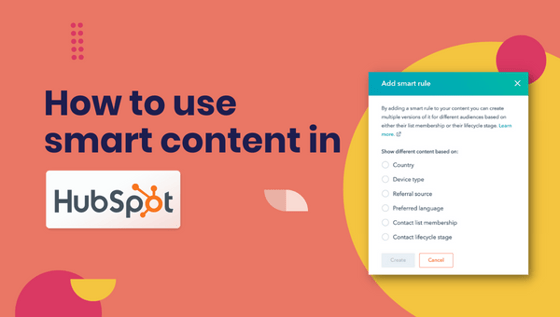






If you're not using smart content as part of your Inbound Marketing strategies, you're missing out on a big opportunity to connect with your audience on a personal level. HubSpot coined the term 'smart content' and it is a key tactic to creating a personalized experience for each and every visitor across emails and landing pages.
What is smart content?
Also referred to as "dynamic" or "adaptive" content, smart content is a term for the aspects of a website, ad, or email body that change based on the interests or past behaviour of the viewer. It creates an experience that's customized specifically for the visitor or reader at that moment.
This means taking into account factors of your visitors such as:
- Location
- Language
- Device type
- Referral source
- Demographics
One of the most well-known examples of smart content is Amazon's recommendation engine, which caters the products and services it shows based on your purchasing behaviour. Other forms of smart content range from personalization fields in emails to entire images or offers on a webpage that shifts based on who's looking at them.
How Does Smart Content Work in HubSpot?
Although it may sound complicated, the theory of smart content is simple in nature. Using the cookies stored in a visitor's browser, HubSpot attempts to identify a visitor coming to your site.
If no previous HubSpot cookie exists, HubSpot buckets the visitor as an unknown contact. From there, it will look at browser settings such as preferred language, device type, and IP address to determine location. If the visitor meets the criteria for any of the smart rules, the smart content will appear accordingly. Otherwise, the default content you have designated will appear.
If there is a cookie from your website that exists in the visitor's browser, HubSpot uses it to identify the visitor and pull information from their respective contact record. After looking at their device presets and IP address, HubSpot will match a visitor against a piece of content's smart rules and show the correct asset.
Currently, HubSpot Marketing Hub Professional and Enterprise customers can create smart CTAs, forms, and rich text modules on landing pages, website pages, or in email.
How Does Smart Content Work with Google?
Google views the default version of a page that has smart content and indexes the page based on that default content so keep that in mind when building pages.
Smart Content: The Good, the Bad, and the Ugly
The Good: Personalization with smart content
Marketers are defined by their ability to build lasting relationships with leads and potential buyers. This requires more than just writing blog posts. It requires creating impactful experiences that inspire trust and delight website visitors at all stages of the buyer's journey.
One of the best ways to do this is through the personalization of content.
As visitors' experience with your company grows, their needs and interests change. Smart content enables you to nurture your leads by providing additional value every time they return to your site. With smart content, you can ensure your visitors are always seeing relevant offers (especially if you're working with different personas), rather than just static resources that aren't applicable to their goals.
In this way, the potential of smart content is two-fold.
- For your website visitors, your site becomes a vast ecosystem of conversion opportunities because they don't have to see the same offer twice.
- Every landing page, form, CTA, or email has the potential to expose new content, services, or products to reconvert a visitor.
The Bad: The success of smart content depends on your CRM hygiene
While top-of-the-funnel contacts can safely be directed to more generic marketing materials, the more qualified someone is, the more personalized their experience with your company should be.
When it comes to filtering known contacts by rules such as list membership or traits like lifecycle stage, it's imperative that you have a clean, well-managed contact database. This ensures that you're aware of what information you have on segments of visitors before making smart rules that won't work as expected.
The success of smart content is based on more than just a healthy CRM. It takes insight into what your customers find valuable at every stage of their journey. This requires understanding what drives your buyer personas to make a purchasing decision, from their goals to problems, to any potential blockers.
If you aren't already aligning and mapping your content to every stage of the buyer's journey, you'll need to do so before you can execute your smart content with excellence. After all, the success of smart content is built on how well your content marketing and segmentation strategies work.
The Ugly: Smart content is impacted by cookies
According to a recent study by Viant Technology, over 60% of marketers believe they will no longer need to rely on tracking cookies for the majority of their digital marketing within the next two years.
This casts a bit of a shadow on software like smart content, which is partially reliant on cookie tracking. Cookies, after all, are notoriously unreliable on mobile, and mobile is becoming the preferred method of browsing online.
In short, don't base the entire infrastructure or conversion opportunities of your site around smart content. Technology and the ways of surfacing data are always evolving. So while cookies may be the way certain pieces of smart content fire now, it's likely they will need to evolve to remain relevant in a mobile-first world.
A healthy mixture of static, dynamic, and conversational content offers is the best type of online ecosystem you can build. See smart content as a means of adding to and supplementing your user's experience, not the all-in-one solution. This way, your website will always look the way you design it for your visitors.
5 Steps for building smart content
1. Determine who you're creating smart content for.
The first thing you’ll need to consider when creating smart content is your audience. Defining who your smart content will be targeted to will help you identify the segmentation criteria and smart rules that will help you adapt your website content to your visitors. To ensure the effectiveness of your smart content for your intended audience, a good place to start is to understand the six different smart rules that can be applied
Depending on whether you’re targeting anonymous visitors or known contacts, some rules will make more sense than others. For anonymous visitors, the available rules will be based on data HubSpot can collect with visitors' IP addresses before they convert on your site, including country, device type, referral source, and preferred language. For known contacts, on the other hand, you will be able to leverage the information you've already collected through the contact list membership and contact lifecycle stage rules.
2. Determine where you want to add smart content.
Once you’ve determined your audience, your next step should be to decide on the elements of your website that will be personalized. HubSpot customers who are hosting their website on HubSpot will be able to add personalization to calls-to-action; forms; and rich text modules on website pages, landing pages, and emails.
We recommend that customers only add personalization to one or two elements per page. Adding personalization to a website page means adding extra layers of complexity, so keeping it easy to manage and measure will help you effectively analyze how your smart content is performing and assist in making more informed decisions.
3. Determine what should be your default content.
For every piece of smart content you create, there will be a default version. This will be the version that will be displayed to visitors who don’t fit your smart rules.
Because your default version will be used for every visitor who doesn’t meet your smart rules, we suggest that you keep your default content as broad and generic as possible. This way, you can ensure the generic version is appealing to everyone and no visitors are seeing content that might not be relevant or useful to them.
4. Determine the value of your smart content.
Smart content is a highly effective feature to nurture your contacts throughout the buyer’s journey by offering them the information and resources that are most relevant to them. It also helps businesses tailor the experience for each unique visitor to build a relationship based on trust. Having clearly defined buyer personas for your business and understanding what their buyer’s journey looks like are key steps for building successful personalization strategies that progress contacts into the next stage of their journey.
When you’re thinking of adding personalization to any element of your website, always take a minute to ask yourself what value it will be adding to your visitors. Most of the time, that value should be translated into an enhanced user experience, whether by optimizing the navigation experience for mobile users, tailoring content to specific countries, or offering valuable new resources to returning contacts to keep growing your relationship with them. If you can’t clearly determine the value of your smart content, it might be a good idea to take some time to strategize and determine the desired effect that you’d like for your smart content to have.
5. Determine how you’ll measure performance.
As you implement smart content on your website, you should be reviewing its performance periodically by analyzing different data points depending on the type of smart content at hand. A useful metric to keep in mind when personalizing rich text modules on website pages will be page views, form submissions will make the most sense for personalized forms, and the number of clicks and click-through rates will make sense for personalized CTAs.
To set realistic target metrics that align with your overall strategy, you should analyze your historical performance data and use those metrics to calculate your goals or compare your smart content against them to make sure there are no dramatic deviations. If you notice that your smart content is underperforming compared to your generic content, it might be a good idea to rethink your personalization strategy to implement edits that could boost your performance.








